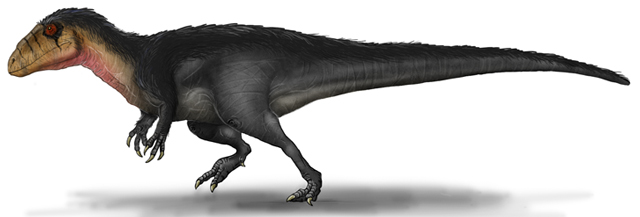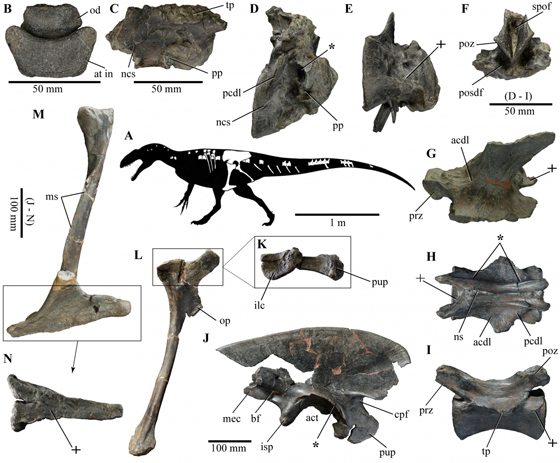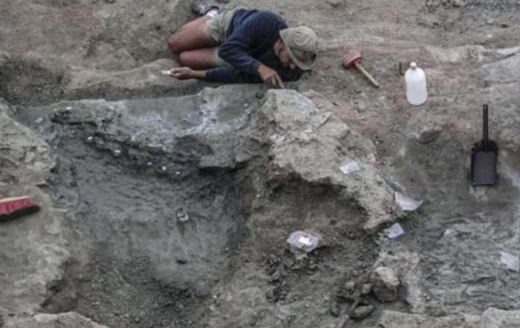The “Hunter of Lusitania” – Lusovenator santosi
The fearsome carcharodontosaurids (family Carcharodontosauridae), comprise some of the largest terrestrial predators that ever lived. Giant theropods such as Giganotosaurus, Carcharodontosaurus and Tyrannotitan rivalled the largest tyrannosaurs in terms of size and probably (in some cases), were even bigger. It had been thought that these types of carnivorous dinosaur were confined to the Cretaceous, but there is a growing body of evidence to suggest that this group was well established and geographically widespread by the Late Jurassic.
Lusovenator santosi
A team of scientists writing in the “Journal of Vertebrate Paleontology” have described a new species of carcharodontosaurid based on fossils found in Portugal. The dinosaur has been named Lusovenator santosi, the genus name translates as “hunter of Lusitania”, a reference to the Lusitanian Basin, the geological region where the fossils are from. Their research supports the idea that these types of predators were present in the Northern Hemisphere some twenty million years earlier than previously thought.
A Life Reconstruction of the Late Jurassic Carcharodontosaurid Lusovenator santosi
Picture credit: Carlos de Miguel Chaves
A Reassessment of Allosaur Fossil Material
The researchers, based in Lisbon and Madrid, re-evaluated fragmentary fossil material collected over the last two decades at sites located on the Portuguese coast about 35 miles (60 kilometres), north of Lisbon. Initial examination suggested that this material represented a member of the Allosauridae, but a more detailed analysis of the fossils led the researchers to conclude that this material represented a dinosaur from the Carcharodontosauridae, a family nested within the clade Allosauria, but distinct from famous Late Jurassic super-predators such as Allosaurus fragilis, which is known from the western United States.
Lead author of the scientific paper, Elisabete Malafaia (University of Lisbon), commented that this discovery demonstrates the importance of the Iberian Peninsula as a key region for understanding the dispersal of carcharodontosaurids as well as other types of dinosaur across the northern hemisphere during the Late Jurassic and Early Cretaceous.
Fossil Material Assigned to Lusovenator santosi
Picture credit: Malafaia et al (Journal of Vertebrate Palaeontology)
One of the Oldest Members of the Carcharodontosauridae
The oldest definitive carcharodontosaurid described to date is Veterupristisaurus (V. milneri) from the Middle Dinosaur Member of the famous Tendaguru Formation of Tanzania. Veterupristisaurus (pronounced Vet-ter-roo-pris-tee-sore-us), is believed to have lived around 154 million years ago (Kimmeridgian faunal stage of the Late Jurassic). Other fragmentary fossil remains from China and Germany have also been tentatively assigned to Late Jurassic carcharodontosaurids. Lusovenator lived around 145 million years ago, as such, it is the oldest carcharodontosaurian allosauroid yet discovered from Laurasia.
The fossil material is believed to represent a relatively young animal, with a body length of approximately 3.5 metres. Although, probably not fully grown, the vertebrae and the ilium show a number of anatomical traits that distinguish Lusovenator from the Allosauridae and nest it with the related, but distinct Carcharodontosauridae.
A Member of a Field Team Working on a Fossil Specimen
Picture credit: LUSA
Furthermore, the identification of this new species expands the diversity of theropod dinosaurs known from the Late Jurassic of Portugal and reinforces the theory that the Iberian Peninsula is a key region to help understand the dispersal of a number of different types of dinosaur across the Northern Hemisphere at the end of the Jurassic and into the Early Cretaceous.
The scientific paper: “A new carcharodontosaurian theropod from the Lusitanian Basin: evidence of allosauroid sympatry in the European Late Jurassic” by Elisabete Malafaia, Pedro Mocho, Fernando Escaso and Francisco Ortega published in the Journal of Vertebrate Paleontology.
The Everything Dinosaur website: Visit Everything Dinosaur.









Leave A Comment